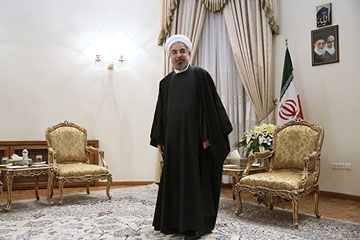A New Beginning in Tehran
< < Go Back
By Robin Wright,
The short-term nuclear deal lifts the fog of hostility to reveal Iran and the U.S. want many of the same things. Is a real rapprochement possible?
For 33 years, I tried to get into the old U.S. embassy in Tehran, which sits behind a brick and metal fence on bustling Taleghani Avenue. I had been at Algiers airport in 1981 when 52 American diplomats, held captive in their own embassy for 444 days, disembarked to freedom. The embassy was then turned into a Revolutionary Guards training center–and made off-limits to Americans. On several trips to Tehran since, I had asked to look inside; I was always turned down.
But in December, shortly after Iran and six world powers signed a temporary nuclear deal–which goes into effect on Jan. 20–I was finally allowed into the place that symbolizes all that went wrong between Iran and the U.S. This time the doors were wide open, and a museum docent took me on an authorized tour.
The main building, two stories of red brick, has the feel of an American public school designed after World War II. Diplomats nicknamed it Henderson High after the first resident ambassador, Loy Henderson.
The embassy seems frozen in time. The gold shag carpet is still there, now flattened and filthy. Vintage teletype machines are loaded with tape. The Iranians have added murals in the hallway, depicting U.S. military interventions from Vietnam to Iraq and Afghanistan. “All these things were done in the name of freedom and human rights,” says Mohammad Reza Shoghi, the docent, referring to the American wars and patting the wall for emphasis. He rattles on with old anti-American rhetoric. The 9/11 attacks were made up, an excuse to invade Afghanistan. American fashion and television shows are designed by psychologists and politicians to destroy foreign cultures. “Exposure to American ideas makes people feeble,” he tells me.
But the bromides about U.S. perfidy no longer reflect the dominant mood in Tehran. Since President Hassan Rouhani’s upset victory in last summer’s election, Iran has been consumed with a strategic recalibration–a reaction to both the electorate’s rejection of hard-line rule and economic hardships produced by eight years of gross mismanagement and increasingly tough international sanctions. The signing of the short-term nuclear deal in November generated tangible change in Iran’s relations with the world, potentially the most important shift since the 1979 Islamic revolution.
Tehran tingles with anticipation–and tension. “The sun is shining again in Iran,” says Nazila Noebashari, owner of Aaran Art Gallery, which often shows the work of young female artists. “There are smart people at the helm.
As the revolution celebrates its 35th anniversary in February, Iran and the U.S. are, after many false starts, on the same page for the first time. The question is whether they can get beyond fear and suspicion to turn that page.
More From TIME Magazine:




